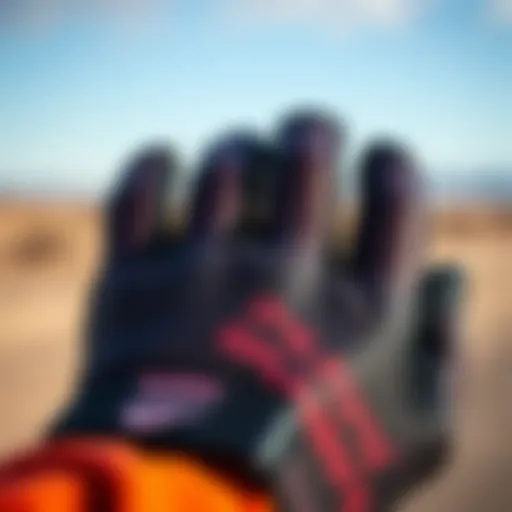Exploring the World of Ozone Kitesurfing
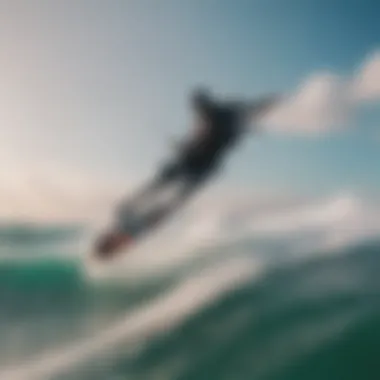
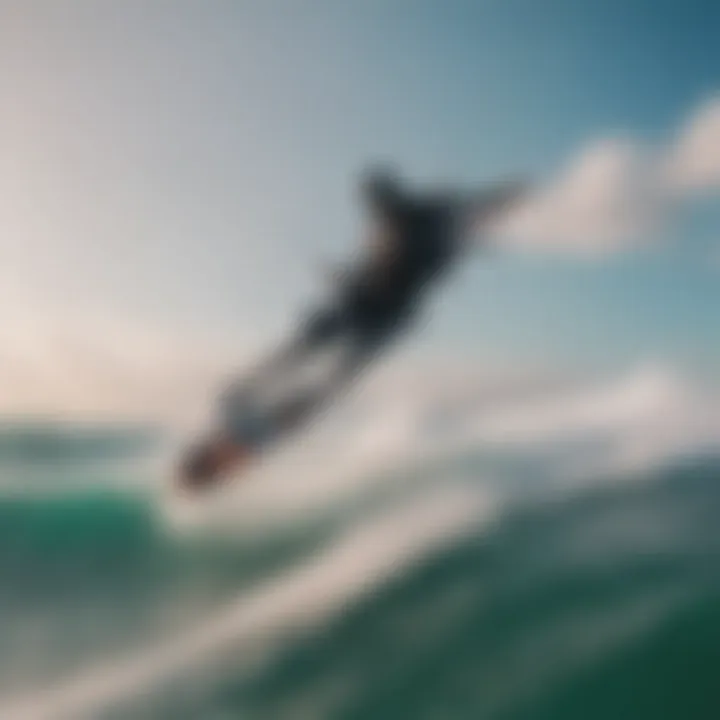
Intro
Kitesurfing has come a long way from its humble beginnings in the surf culture to becoming a thrilling sport practiced around the globe. Among the various options available, Ozone kitesurfing stands out for its performance, user-friendly design, and adaptability. However, to fully appreciate this thrilling venture, one must delve into several related aspects.
This article offers an in-depth look at the multifaceted realm of ozone kitesurfing, aiming to illuminate not only its history and gear but also the techniques and safety practices involved. Whether you’re a total novice looking to dip your toes into this water sport or an experienced rider seeking to refine your skills, we’ve got you covered. From discussing gear choices and their specifications to pointing out prime travel getaway for kitesurfing, we will unpack the exhilarating world of ozone kiting.
The knowledge contained within these sections will prove essential as you navigate the wind and waves. So let’s jump right in and explore the essentials!
Gear Insights
When it comes to kitesurfing, the right gear can make a compelling difference. Ozone kites are renowned for their cutting-edge designs and attention to detail, making them some of the best in the market. Let’s break down two critical areas: the latest gear reviews and the essentials for beginners.
Latest Gear Reviews
Recent innovations in Ozone kites have brought some impressive features to the table. For example, the Ozone Enduro V3 has made waves for its versatility, making it suitable for both novices and experienced riders. Its lightweight construction and responsiveness allow for optimal performance across a range of wind conditions.
Another noteworthy mention is the Ozone Catalyst. Known for its easy relaunch capabilities, it provides an edge when tackling those challenging aerial maneuvers. Riders appreciate its stability, which is crucial during gusty days.
In today’s fast-paced kitesurfing scene, choosing gear with the right specifications can be overwhelming. Therefore, aligning your choice with your intended use—be it for freestyling or wave riding—becomes vital.
Essential Gear for Beginners
For those who are just starting out, the plethora of options might feel daunting. To ease into the sport, it makes sense to consider essential gear wisely. Here are some fundamental items:
- Kite: Start with a smaller, forgiving kite that suits your weight and the likely wind conditions.
- Board: A larger board aids in stability and makes learning to plane easier.
- Harness: A comfortable harness is non-negotiable; it transfers the kite’s power and allows for better control.
- Safety System: Ensure your gear has a reliable quick-release safety feature.
- Wetsuit: Depending on your water temperature, a wetsuit becomes crucial for protection from the elements.
These items lay the foundation for your kitesurfing adventure, and understanding them is key to enhancing your experience on the water.
Techniques and Tips
No discussion on kitesurfing would be complete without talking tactics. Achieving proficiency in this sport requires learning both basic and advanced techniques while keeping safety front of mind.
Advanced Tricks and Techniques
For the seasoned kitesurfer, pushing the boundaries in skill is part of the thrill. Some recommended tricks to hone in on are:
- Jumping: Start mastering the art of jumping to feel the adrenaline rush. Keep your kite high and use your board’s edge for lift.
- Unhooked Tricks: These require a solid understanding of kite control. Begin with simple moves and gradually progress to more complex tricks.
- Downlooping: A technique involving looping the kite while jumping that adds flair to your maneuvers. It requires practice, and timing is everything.
Safety Practices for Kiteboarders
Regardless of your skill level, adhering to safety practices can prevent accidents:
- Check Your Gear: Before hitting the water, ensure all your equipment is in top shape.
- Know the Conditions: Familiarize yourself with the wind and wave predictions of your chosen location.
- Buddy System: Kiting with a friend not only makes it enjoyable but also ensures assistance when needed.
- Safety Zones: Stay clear of areas marked off for swimmers or boats.
"Kitesurfing is about harmony between the rider, the kite, and the environment; understanding and respecting this balance is the key to both performance and safety."
As you gear up for your next excursion, remember that both techniques and safety are essentials for a successful adventure. Equipped with the right knowledge, your ozone kitesurfing experience can truly reach new heights.
Understanding Ozone Kitesurfing
The world of kitesurfing offers an exhilarating blend of thrill, speed, and skill, but understanding Ozone kitesurfing brings its own unique insights to the table. This specific discipline is not just a fleeting trend in water sports; it represents a significant evolution in how enthusiasts engage with the wind and water. By delving into the nuances of Ozone kitesurfing, participants can cultivate a deeper connection with the sport, allowing for a more enriching experience.
Ozone kites, known for their robust design and optimized performance capabilities, set the stage for a kitesurfing experience that ranges from serene gliding to exhilarating jumps. Recognizing the different attributes of these kites is essential for both beginner and seasoned riders. Understanding Ozone kitesurfing means more than just having the right gear; it's about appreciating the mechanics, weather conditions, and local culture surrounding the sport.
This exploration is critical, as it helps riders avoid pitfalls, enhance their safety, and maximize their enjoyment on the water. Exploring this subject opens the door to a community filled with passion and commitment, where exchanging tips, tricks, and experiences is commonplace.
Definition and Overview
Ozone kitesurfing is fundamentally about harnessing the power of wind to propel oneself over water using specially designed kites. These kites are integral components of the sport, influencing everything from stability to lift and speed. Ozone Kites primarily focus on providing a smooth user experience, making them suitable for a range of skill levels.
At a basic level, kitesurfing involves using a kite and a board, combining elements of sailing and surfing. Riders use the kite to control their movement, maneuvering across the water's surface. The physical mechanics might seem complex, but mastery of the various techniques can bring immense satisfaction and joy.
Historical Context
The roots of kitesurfing trace back to the late 1960s and 1970s, where early pioneers tried to combine surfing with kite flying. However, it wasn’t until the 1990s that kitesurfing gained popularity. The introduction of the inflatable kite revolutionized the sport, making it more accessible and safer. Amid this evolution, Ozone Kites emerged, characterized by their innovative design and a commitment to performance.
Since that time, Ozone has connected with a global community of kitesurfers. Events, competitions, and riding spots have sprouted up around the world, illustrating how the sport has transcended geographical boundaries. The brand emphasizes user experience and promotes learning, often leading to the development of riders who not only tackle waves but also embody the spirit of kitesurfing.
Ozone Kitesurfing is not just a sport; it's a lifestyle that fosters community, adventure, and a deeper connection with nature.
As we plunge into each aspect of Ozone kitesurfing, we're not merely scratching the surface; we're unraveling an intricate tapestry of history, technology, and personal connection.
Ozone Kites: A Closer Look
Delving into Ozone kites is essential for a comprehensive grasp of kitesurfing, particularly when it comes to enhancing your performance and overall experience on the water. Ozone kites are renowned for their innovative design, robust construction, and excellent performance metrics, making them a go-to choice for many kitesurfing enthusiasts.
These kites not only cater to kitesurfers of all levels but also adapt to various conditions and riding styles. This section sheds light on the design intricacies and performance indicators, which both play pivotal roles in ensuring optimal kitesurfing that is both thrilling and safe.
Design and Construction
The design of Ozone kites is one of the foundational aspects that sets them apart. Each kite is crafted with a keen eye on aerodynamics and material performance. Most notably, these kites utilize a high-quality ripstop fabric, which not only offers unparalleled durability but also enhances the kite's overall efficiency in flight. This fabric is lightweight and reduces drag, allowing for better aerial maneuvers.
Another key feature is the internal structure of Ozone kites, which often incorporates a unique reinforcement system. This means kites can withstand the stresses of powerful winds while maintaining stability and control. Plus, the specific canopy shapes used, which vary from model to model, provide different performance qualities suited for diverse riding styles.
In essence, the design and construction of Ozone kites are meticulously engineered to create a balance between speed, stability, and handling, which are crucial for both novice and expert riders.
Performance Metrics
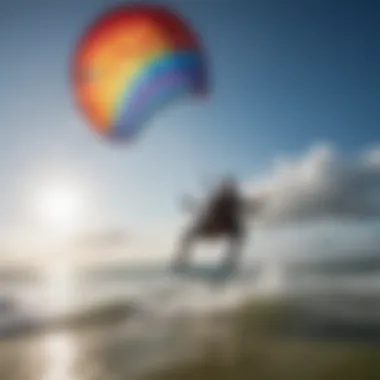
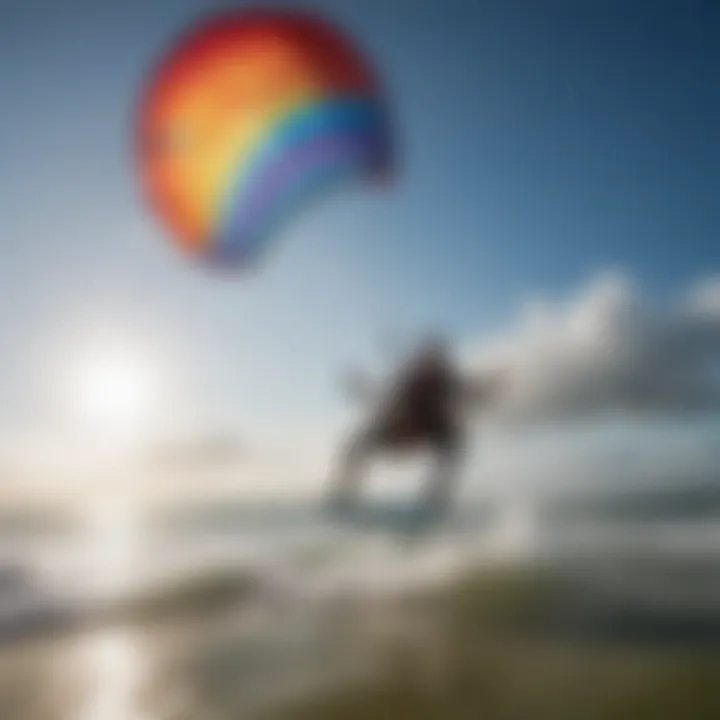
Understanding the performance metrics of Ozone kites informs kitesurfers about how these kites will behave under different conditions. The metrics often discussed include lift and stability, speed and responsiveness, and wind range capabilities.
Lift and Stability
Lift and stability are fundamental for creating an enjoyable kitesurfing experience. Ozone kites are often recognized for their ability to generate substantial lift while ensuring stability even in gusty conditions. This is primarily achieved through the kite's design and the shape of the leading edge, which minimizes turbulence and enhances airflow over the surface.
This characteristic is advantageous because it allows riders to perform jumps and tricks confidently, knowing their kite will maintain its position in the air without unwanted fluttering. As a result, kitesurfers can focus more on their technique rather than worrying about kite control.
Speed and Responsiveness
Speed and responsiveness are another critical facet of Ozone kites. Kites of this brand are designed to respond swiftly to rider inputs, a feature that enhances both thrill and safety. This quick response to steering is often due to how the lines are rigged and the kite's overall weight distribution.
What sets Ozone apart is its commitment to ensuring that riders feel connected to their kite. This connection fosters an intuitive riding experience, wherein even newcomers can find immediate satisfaction and quickly progress. However, a downside is that some models may require finesse in handling, which can be challenging for those just starting out.
Wind Range Capabilities
Wind range capabilities denote how well a kite performs in varying wind conditions. Ozone kites are specifically engineered to handle a broad spectrum of wind speeds, making them suitable for different environments, whether you're in light wind or chasing stronger gusts.
This versatility opens up opportunities for kitesurfers to ride in conditions that might be unsuitable for other kites. Still, this advantage comes with a caveat: proficiency in understanding wind dynamics is essential. If a rider misjudges the wind, even the best kite can lead to trouble. Therefore, equipping oneself with knowledge about wind patterns is crucial.
"The beauty of Ozone kites lies in their perfect blend of powerful lift, agile speed, and adaptable wind range, catering to every kitesurfer's needs."
Selecting the Right Gear
Choosing the right gear is fundamental in kitesurfing, particularly when it comes to working with Ozone kites. Your equipment isn’t just a set of accessories; it’s an essential element that impacts your performance and safety. It’s kind of like picking the right pair of shoes for a hike – the wrong choice can lead to uncomfortable experiences or worse, injuries.
Kite Sizing Guide
When it comes to kites, size matters. The kite’s size dictates how it interacts with the wind. In essence, larger kites generate more power but demand higher wind speeds, while smaller ones are suitable for less windy conditions. Navigating this balance is vital, and here are a few aspects to consider:
- Rider Weight: Heavier riders will benefit from larger kites, whereas lighter ones might opt for smaller sizes.
- Wind Conditions: Familiarize yourself with your typical riding environment. If you're used to feather-light breezes, a larger kite might serve you better.
- Skill Level: Beginners may find larger kites challenging as they respond quickly to the wind, making it harder to manage.
Essential Accessories
Equipping yourself with the right accessories can make all the difference. Here’s a breakdown of some crucial items that can enhance your kitesurfing experience.
Bars and Lines
The control bar and lines are the lifelines of your kitesurfing rig. They connect you directly to the kite and allow you to maneuver it through the wind. A noteworthy characteristic of bars and lines is their responsiveness. This can give you a better feel of the kite, which is super important for precision flying.
A popular choice among riders is the Ozone Control System, known for its durability and ease of use. One unique feature is the color-coded lines, which helps beginners rapidly identify which line is which, minimizing confusion. However, it's worth mentioning that while thicker lines are more durable, they can also be heavier and less responsive, thus impacting performance in lighter winds.
Harnesses
Harnesses are another key component, as they connect you to the kite while taking the strain off your arms and shoulders. A waist harness is commonly preferred for its combination of flexibility and support. The critical aspect of harnesses is comfort; yes, they have to fit snugly but also allow free movement.
A notable feature of Ozone harnesses is their quick-release safety mechanism which can be a lifesaver in emergencies. On the downside, finding a harness that sits well can sometimes feel like looking for a needle in a haystack, as personal preference varies widely.
Safety Systems
In an adventure sport like kitesurfing, safety is paramount. Ozone has placed a strong emphasis on incorporating robust safety systems into their designs. One key characteristic is the single line flagging system, which allows the kites to be depowered quickly in case of unforeseen situations.
This system significantly enhances rider safety and control, making it an advantageous addition to Ozone kites. However, it’s important to mention that like any safety mechanism, understanding how to use it properly is essential for it to be effective.
In sum, selecting the right gear, from kite sizes to harnesses and safety systems, is a cornerstone of ensuring a fulfilling and safe kitesurfing experience. Through careful consideration and a little research, you can elevate your skills and enjoy the thrill of riding the waves with confidence.
Techniques for Ozone Kitesurfing
Mastering the techniques of ozone kitesurfing is vital for both safety and performance. Understanding how to control the kite effectively can transform an average session into a spectacular one. Each technique builds the foundation for a skillful ride, and with proper execution, a kitesurfer can enjoy the leisure of the sport without unnecessary risks.
Basic Kitesurfing Techniques
Launching
Launching a kite is the first hurdle any kitesurfer must overcome. This involves getting the kite into the air without it crashing or causing mishaps. A successful launch sets the tone for the entire session. The primary characteristic that defines a good launch is timing. If done at an opportune moment, the kite will rise smoothly, ensuring a safe and controlled start.
The unique feature of launching comes down to the importance of the wind's direction and strength. A kite brought up in crosswind can help it gain altitude more efficiently. However, if the wind is gusty, it can be a double-edged sword, leading to erratic behavior.
- Advantages: A well-executed launch permits a swift entry into riding mode.
- Disadvantages: A poorly timed launch can result in injuries or equipment damage.
Landing
Landing, while often overlooked, is another critical part of kitesurfing. Just as important as launching, proper landing ensures that the kitesurfer returns safely back to shore. The key aspect of landing is control; it governs how smoothly one descends back to the ground or water.
The uniqueness of landing lies in its requirement for situational awareness. The kitesurfer must observe their surroundings closely to ascertain the safest direction to land the kite. Adjusting the kite's angle relative to the wind plays a crucial role in achieving a successful landing.
- Advantages: Controlled landings minimize risk and enhance user experience.
- Disadvantages: Uncontrolled landings jeopardize both the kitesurfer's safety and equipment durability.
Riding Fundamentals
Riding fundamentals are the bread and butter of kitesurfing. This covers everything from how to position your body, to controlling the kite, and balancing on the board. The key characteristic here is balance. A kitesufer who can maintain balance not only enjoys a smoother ride but also has more control over their movements.
A notable feature of these fundamentals includes the use of one's body as a counterweight to the kite’s pulling force. Maintaining a low center of gravity helps in absorbing the pulls and waves while riding. The fundamentals form the cornerstone of every kitesurfer’s knowledge base.
- Advantages: A strong understanding of riding basics promotes versatility on the water.
- Disadvantages: Neglecting these fundamentals can lead to frequent falls and crashes.
Advanced Maneuvers
Jumping Techniques
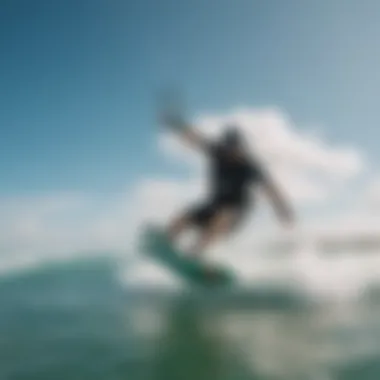
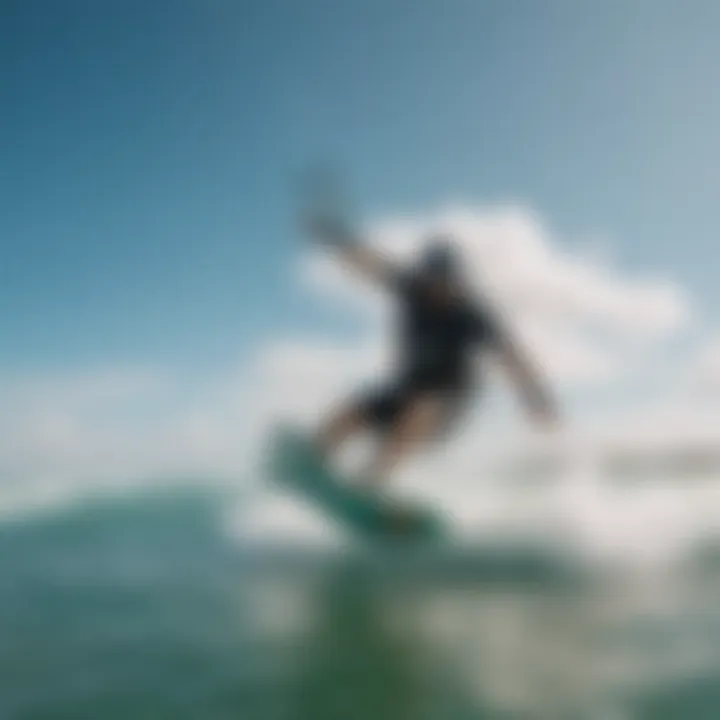
Jumping in kitesurfing is not just about getting airborne; it's about mastering the art of lift and control. Here, the key element is pop: the sudden upward force generated as you cut across the wind. Jumping allows for an exhilarating experience, offering the thrill of soaring high above the water.
The uniqueness of jumping techniques lies in mastering the timing between kite pull and board movement. A well-timed jump exploits the wind's lift effectively, allowing for graceful airtime.
- Advantages: A good jump creates a dynamic, exciting ride and increases skill level.
- Disadvantages: Poor technique can lead to hard landings, risking injury.
Tricks and Stunts
Tricks and stunts in kitesurfing push the boundaries of the sport. They require dexterity and an understanding of the kite's behavior in the air. The key characteristic here revolves around creativity—the sky's the limit when it comes to what can be attempted.
The uniqueness lies in combining basic techniques with personal flair, thereby personalizing the kitesurfing experience. Each kitesurfer can develop their signature moves, adding an element of individuality to the sport.
- Advantages: Successful execution of tricks boosts confidence and enhances interaction within the kiting community.
- Disadvantages: Risk of injury increases without proper progression and experience.
Transition Skills
Transitions are what allow kitesurfers to switch from one direction to another fluidly. This skill builds on the understanding of balance and kite control. A transition is seamless when executed properly, often leaving spectators in awe.
Unique to transitions is the flow: a successful transition keeps the ride continuous, allowing a kitesurfer to maintain speed and momentum without losing rhythm. Mastery of transitions increases a rider's versatility on the water.
- Advantages: Smooth transitions enhance the overall experience and style.
- Disadvantages: Clunky transitions can disrupt flow and may lead to falls.
Mastering the techniques of ozone kitesurfing not only enriches your own experience but also elevates the entire kiting community.
Safety Considerations
When it comes to kitesurfing, safety isn’t just a suggestion; it’s essential. The thrill of riding the windy waves can quickly turn into a precarious situation if the proper precautions aren’t taken. Ensuring that you understand and prioritize safety is paramount to not only enhancing your experience but also to reducing risks associated with the sport. In this section, we’ll touch on the significance of both weather understanding and personal safety measures, giving you a comprehensive view on how to stay safe while enjoying the ride.
Understanding Weather Conditions
Analyzing Wind Patterns
Wind is the very breath of kitesurfing. Knowing how to analyze wind patterns can make or break your day on the water. This analysis allows you to predict how the wind will behave, which is a crucial part of preparation. Good kitesurfers keep one eye on the sky and one eye on the water, as the conditions can change faster than a flick of a switch.
Key characteristics of wind patterns include:
- Consistency: Steady wind makes for smooth rides, while gusty winds can toss you around like a rag doll.
- Direction: Wind direction often impacts how you set up for takeoff and landing. A cross-shore wind can mean safer landing but may complicate takeoff.
A beneficial method for analyzing wind is using local weather apps or websites that specialize in marine forecasts. These tools can provide you with real-time information about wind speed and direction, ensuring you know what’s coming your way.
However, reliance on technology comes with a downside; not all apps are perfectly reliable, and they can sometimes predict the wrong conditions. Being knowledgeable about local weather changes is a considerable advantage that can save you from unexpected surprises.
Identifying Hazardous Conditions
Hazardous conditions can sneak up on even the most experienced kitesurfers. This section will explore how to spot these trouble signs before they escalate into dangerous scenarios. Recognizing hazards is not just about observing the water; it's about trusting your instincts and being aware of your environment.
Key characteristics of hazardous conditions include:
- Sudden Storms: They can whip up rough waves and unpredictable winds in no time. It's vital to monitor weather alerts.
- Surf and Tidal Changes: High tides can expose new dangers underwater, while low tides might bring you closer to the rocks.
Understanding how to analyze these conditions effectively is crucial for your safety. It’s also a reminder that just because the water looks inviting doesn’t mean it’s safe. Many enthusiasts have had to cut their sessions short or avoid them altogether due to unexpected changes in the weather or water conditions. On the upside, locals often share insights on conditions, which can be a tremendous advantage for newcomers.
Personal Safety Measures
Proper Usage of Safety Gear
Wearing the right gear is like putting on a seatbelt before driving; it’s a fundamental safety measure. Using safety gear not only protects you physically but also keeps your mind at ease while on the water. Making this fundamental part of your setup can make a world of difference in an emergency.
Key characteristics of proper safety gear include:
- Harness: A well-fitted harness distributes pressure, ensuring comfort during your ride.
- Impact Vest: This can shield you against accidental falls, allowing for safer landings.
When choosing safety gear, make sure it fits properly and is suitable for your specific needs. Buying quality gear isn’t just about brand names; it often goes hand-in-hand with safety. One might think that high prices are misleading, but the continued durability and reliability of branded safety gear typically outweigh the costs.
Emergency Procedures
Emergency procedures are your best friends when things go sideways. Knowing what to do in an emergency can be the difference between a close call and a serious incident.
One key feature of emergency procedures is that they create a plan before trouble strikes. Familiarizing yourself with standard processes like how to signal for help, managing equipment failures, or what to do if you’re in a hazardous area can significantly boost your confidence. Sometimes, all it takes is a knowledge of local rescue services to give you the greatest reassurance.
An emergency plan should include:
- Communication: Always have a way to communicate with others on land or in the water. This could be a whistle or a portable radio.
- Exit Strategies: Know how to get back safely in various conditions. Make a habit of scouting landing sites before getting out on the water.
Traveling for Ozone Kitesurfing
Traveling specifically for ozone kitesurfing opens up a treasure chest of experiences worth diving into. Beyond just the thrill of riding the waves, this segment of our exploration helps kitesurfers discover new waters, connect with diverse communities, and enhance their overall skills. Picking the right destination can mean the difference between an average trip and an adventure that you’ll reminisce about for years to come.
A key element of kitesurfing travel is the pursuit of wind and water conditions that are tailor-made for this exhilarating sport. Often, seasoned kitesurfers will plan their travels around seasonal wind patterns and local weather forecasts, aiming for places known for pristine conditions. Furthermore, these travels often lead to confluences of like-minded individuals, fostering an enriching environment for learning and sharing.
Top Destinations for Ozone Kitesurfing
Local Insights
When considering local insights, understanding the varied landscapes and cultural nuances of popular kitesurfing spots can significantly enhance a kitesurfer’s experience. For example, locations like Tarifa in Spain are not just about the backdrops but about immersing oneself in the vibrant local culture filled with cafes buzzing with fellow kitesurfers. With affordable accommodations and locals who are passionate about the sport, Tarifa becomes a beloved hub for practitioners of all levels.
Many cities offer hidden gems, often overlooked by casual travelers. These jewels can serve as the ideal training grounds due to their consistent wind and friendly water conditions. Places like Cumbuco in Brazil provide unique features such as warm wind currents and shallow waters, making it a great spot even for beginners to get their feet wet without fear.
Some advantages include accessibility to specialized schools which might offer local guides who know the area like the back of their hand. However, these popular areas can get crowded, making it sometimes difficult to find that coveted quiet spot.
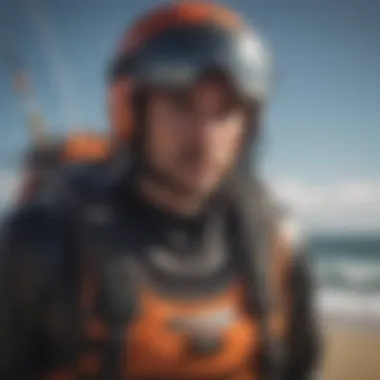
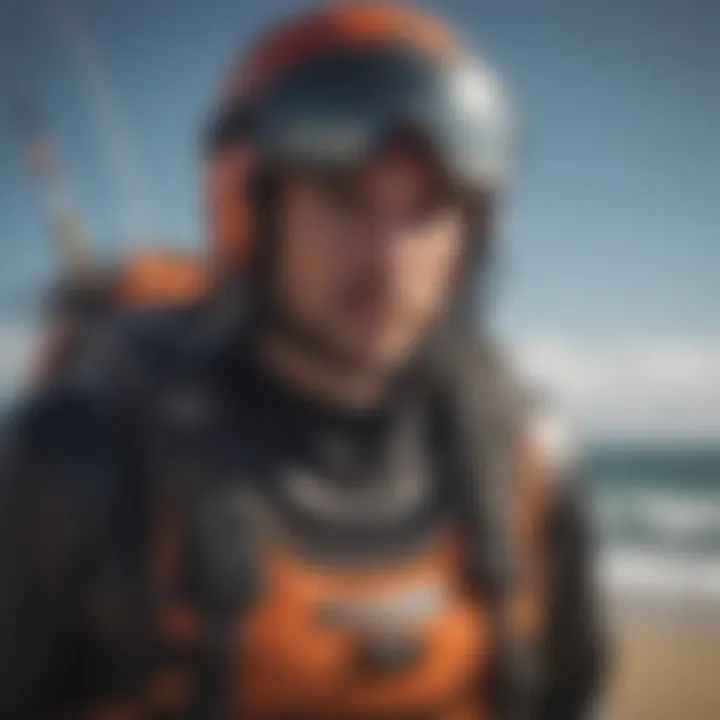
Facilities and Amenities
Facilities and amenities surrounding kitesurfing spots play a pivotal role in the overall experience. Ideal locations often boast well-maintained beaches with proper access points, ensuring that launching and landing the kite is a smooth endeavor. Moreover, amenities like rental shops provide everything from kites to safety gear, allowing travelers the convenience of packing light.
Another key characteristic is the availability of local surfing schools that cater to various skill levels. In places like Cabarete, Dominican Republic, schools often provide comprehensive packages which include lessons, rentals, and sometimes, even accommodations. This can be a tremendous benefit for newcomers aiming to get started in a supportive environment.
On the downside, the cost of some facilities can be a discouragement; prices can shoot up during peak seasons. Therefore, checking for off-peak travel advisories might save some bucks while reaping the benefits of nearly deserted waters.
Cultural Experiences While Kiteboarding
Kitesurfing is not simply an individual pursuit but often evolves into a vibrant cultural experience. When traveling, kitesurfers experience unique traditions, local cuisines, and interactions with fellow enthusiasts that truly color the trip. Festivals celebrating wind or watersport, often held in coastal towns, become social nodes, drawing both international and local crowds, thereby facilitating friendships and camaraderie.
Exploring different cultures can also spark new techniques or styles in kitesurfing, as different regions tend to develop distinct methods based on their conditions and equipment preferences. This kind of exchange is invaluable, enriching not only the sport but broadening the kitesurfer’s horizon in ways that mere practice cannot.
Traveling for kitesurfing is not just about adventure; it’s about understanding the rhythms of wind and waves shaped by unique cultures.
In essence, traveling for ozone kitesurfing catalyzes growth—both the skillful kind and the profound appreciation for the sport interactions with the global kitesurfing community enable. Each trip holds the potential for discovery, learning, and connection, truly making it a pursuit worth undertaking.
Environmental Impact of Kitesurfing
Kitesurfing is not just a thrilling sport; it also carries environmental implications that need careful consideration. As more enthusiasts hit the waves, the effects on marine ecosystems become increasingly significant. Understanding these impacts is crucial for promoting sustainability and preserving the natural beauty of our coastlines. Every kite session can either support or harm the environment, making awareness of these dynamics essential for responsible practitioners.
Sustainable Practices
To mitigate the environmental consequences of kitesurfing, adopting sustainable practices is key. This involves a combination of personal choices and collective actions. From selecting eco-friendly gear to being mindful of local wildlife, kitesurfers can play a vital role in minimizing their footprint.
- Eco-Friendly Gear: Choosing kites and accessories made from sustainable materials reduces the strain on natural resources. Brands are increasingly aware of their impact and are shifting toward greener options.
- Waste Management: It's important for riders to take all trash back home, including old lines and broken gear. Responsible disposal contributes measurably to the health of marine environments.
- Local Engagement: Connecting with local conservation initiatives can amplify individual efforts. Getting involved in beach clean-ups or educational programs can lead to a deeper appreciation for areas where one rides.
By embracing these practices, kitesurfers can champion the cause of preserving the sport's environment while enhancing their experiences.
Preserving Natural Habitats
Preserving natural habitats is another essential part of kitesurfing's environmental considerations. The training and awareness of responsible riding are necessary to maintain the delicate balance of local ecosystems. When individuals prioritize habitat conservation, they contribute significantly to the sustainability of kitesurfing areas.
Responsible Riding
Responsible riding refers to the practices kitesurfers adopt to minimize the disturbance to their surroundings. This includes avoiding sensitive areas, such as nesting sites for seabirds or fragile marine ecosystems.
- Key Characteristics of Responsible Riding: This practice emphasizes awareness of one's impact on the environment. Ride only in designated zones to avoid harming wildlife.
- Why It Matters: It not only helps preserve the environment but also ensures that kitesurfing remains viable in the long term, protecting it for future generations.
- Unique Features: Responsible riding encourages riders to educate themselves on local ecosystems, enhancing their overall kiteboarding experience while fostering a deeper connection to nature. In this way, it stands out as a conscious choice for enthusiasts.
Community Initiatives
Community initiatives often take the forefront in preserving natural habitats, especially through organized groups focused on conservation efforts related to kitesurfing.
- Key Characteristics: Such initiatives typically involve partnerships with local organizations to create awareness campaigns and promote environmentally friendly practices among riders.
- Benefits: These groups often conduct beach clean-ups, habitat restoration projects, and educational sessions, making conservation efforts more impactful and engaging.
- Unique Features: By pooling resources and offering a platform for discussion, community initiatives inspire individuals to share their experiences and insights, fostering a camaraderie among riders centered around shared values.
Community and Culture of Ozone Kitesurfing
The community aspect of ozone kitesurfing is as crucial as the physical sport itself. Being part of a vibrant group can greatly enhance one's experience, whether you are a beginner feeling the rush of the wind for the first time or a seasoned rider pushing for the latest tricks. This section explores how belonging to the kitesurfing community enriches lives, fosters skill development, and strengthens bonds, all while adding layers of fun and support to the sport.
Connecting with Other Enthusiasts
Engaging with fellow kitesurfers is invaluable. The connection we feel drives motivation and creates a shared enthusiasm that is hard to match. Not only do friendships blossom in these waters, you pick up tips, trade gear, and learn about the latest techniques.
For instance, local kitesurfing schools often host meetups or beginner courses to help newcomers feel welcomed. These gatherings act as informal classrooms that encourage sharing of knowledge—no one feels left out.
- Social Media and In-Person Meetups: Platforms like Facebook and Reddit serve as perfect venues for organizing events, planning trips, or sharing experiences. It's often said that "the more, the merrier." Local kitesurfing communities frequently organize group outings for a fun-filled day on the water.
- Networking Opportunities: Beyond just riding together, being part of a community allows gear exchanges and learning from others' experiences. If someone’s trying a new trick, chances are others will hop on their boards to give it a shot too.
Events and Competitions
Participating in events and competitions adds an exciting layer to the kitesurfing culture. They provide opportunities to showcase skills and meet like-minded individuals, creating a sense of belonging.
Local Competitions
Local competitions play a pivotal role in nurturing talent. They allow riders of all levels to participate in a friendly yet competitive environment. These events often foster camaraderie, as participants cheer each other on, creating a festive atmosphere.
- Accessibility: Local events tend to be less intimidating for beginners. They provide a supportive environment where novices can challenge themselves without the pressure of a more significant stage.
- Community Spirit: Events often involve not just the competitors but also families and friends who come to support. This fosters a sense of unity that is both welcoming and encouraging. It’s common to see riders helping each other, sometimes even trading strategies before their runs.
Global Events
Global events, like the Kite Park League, elevate the kitesurfing culture to new heights. These competitions feature the world’s best riders showcasing jaw-dropping skills and pushing limits.
- Exposure: For local riders, participating in global competitions not only puts them on the map but also opens doors to sponsorships and professional opportunities. It's an ideal platform to gain visibility in the wider kitesurfing community.
- Inspiring the Next Generation: Young riders often look up to these competitions. Seeing their idols in action can ignite the spark of passion, encouraging younger generations to pursue the sport with vigor and enthusiasm.
In summary, the community and culture of ozone kitesurfing serve as foundation stones for both enjoyment and growth in the sport. Whether through local competitions or global showcases, the bonds formed and experiences shared contribute significantly to the kitesurfing journey, making it not only a sport but a way of life.
Future of Ozone Kitesurfing
The future of ozone kitesurfing holds immense promise, characterized by a confluence of technological advancements and an ever-expanding global community. As the sport evolves, kitesurfers, from novices to seasoned pros, will discover new ways to engage with the waves and the wind. This section aims to explore key elements that will likely shape the future landscape of this thrilling sport, highlighting innovation trends, upcoming challenges, and their implications for enthusiasts all over the world.
Innovation Trends
Innovation in ozone kitesurfing is gaining momentum as manufacturers and designers push boundaries and explore new possibilities.
- Material Advancements: The shift towards lighter, more durable materials offers not only enhanced performance but also greater longevity for gear. Companies are experimenting with composite materials, reducing drag and improving lift—both crucial for maneuverability and speed.
- Smart Kites: Imagine kites equipped with sensors providing real-time data on wind conditions, kite performance, and even personal metrics like heart rates. These smart kites could revolutionize how enthusiasts interact with their gear, providing insights for better riding experiences.
- Modular Designs: The trend of modular kites could emerge, allowing riders to customize their equipment on-the-go based on the conditions. If one component wears out, it could be easily replaced without the need to replace the entire kite.
"As the horizon expands, so too does our potential to redefine the boundaries of kitesurfing."
These innovations don’t just enhance the kitesurfing experience—they bolster safety and accessibility as well. Enhanced safety features and adaptable designs mean that more people can participate in this exhilarating sport without compromising their well-being.
Challenges Ahead
Despite the bright prospects, the future of ozone kitesurfing is not without its challenges. The community must navigate various hurdles to sustain the growth and evolution of kitesurfing.
- Environmental Impact: As kitesurfing gains popularity, its potential effects on marine environments cannot be ignored. Issues regarding pollution, habitat disruption, and interaction with wildlife are pressing. Riders must foster a culture of environmental awareness and promote sustainability.
- Market Saturation: An influx of products, techniques, and brands could lead to market saturation, making it overwhelming for new enthusiasts. Instructors and seasoned riders must step up to guide newcomers through the maze of choices, ensuring they don’t feel lost or discouraged.
- Technological Overdependence: As gear becomes smarter and more integrated with technology, there's a risk that riders might rely too much on their equipment, neglecting essential skills. Balancing technology with foundational kitesurfing abilities will be crucial for upcoming generations.













